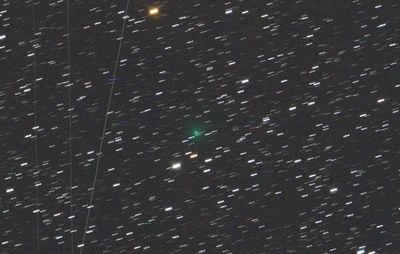A big new sungrazing comet
Astronomers are buzzing about a new comet discovered just a few days ago. It's so new, it doesn't have a name yet. Provisionally designated "A11bP7I," the comet appears to be a relatively large sungrazer on course to become a bright naked-eye object in late October.

We are here in Namibia to observe Tsuchinshan Atlas. The new Kreutz comet was discovered not far away. It is already 11mag bright, shows a 2' coma and a short tail. Dennis Möller exposed 15x60 seconds with his self-made astrograph. The device was carried 10,000 kilometers in its case. We can follow the development for a few more days. Observers: Dennis Möller, Michael Jäger, Gerald Rhemann
"We are here in Namibia to observe Comet Tsuchinshan-ATLAS," says Jäger. "The new sungrazing comet was discovered not far away, so we took a look. It is already 11th mag with a 2' green coma and a short tail."
The orbit and brightness of A11bP7I remind experts of Comet Lovejoy (C/2011 W3), a sungrazer that flew through the sun's atmosphere in Dec. 2011. Comet Lovejoy emerged from the close encounter intact and put on a spectacular show for amateur astronomers in the southern hemisphere.
Like Lovejoy, the new comet is a member of the Kreutz family. Kreutz sungrazers are fragments from the breakup of a giant comet ~2000 years ago. Every day, several fragments pass by the sun and disintegrate; indeed, SOHO coronagraphs have discovered thousands of them. As a rule, they are very small, but A11bP7I could be an exception--a big fragment that survives the heat and becomes visible to the naked eye.
Experts have also noted a similarity between the orbits of A11bP7I and Great Comet Ikeya–Seki (C/1965 S1). In 1965, Ikeya–Seki became so bright when it passed by the sun that it was visible in broad daylight at magnitude -10. Japanese observers famously saw it at high noon.
Sungrazing comet expert Karl Battams of the Naval Research Lab sounds a note of caution: "While I hope with all my heart for an Ikeya-Seki 2.0, it seems this could be a smaller Kreutz fragment that has simply erupted a little ahead of schedule [making us think it is bigger and brighter than it actually is]. Comparisons with Ikeya-Seki should be treated with extreme caution, but something akin to Comet Lovejoy are certainly not out of the question "
This is a developing story. Stay tuned!